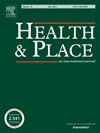邻里关系:西班牙裔青少年体重不健康的邻里劣势与癌症预防行为的探讨
IF 3.8
2区 医学
Q1 PUBLIC, ENVIRONMENTAL & OCCUPATIONAL HEALTH
引用次数: 0
摘要
目的本研究旨在评估青少年癌症预防行为(CPB)(即健康饮食摄入和体育活动)、父母压力、父母社会人口特征(即教育、家庭收入和婚姻状况)以及区域剥夺指数(ADI)测量的社区影响之间的关系。此外,我们还研究了父母压力是否介导了ADI与青少年CPB之间的关系。方法280例西班牙裔青年的基线数据(Mage = 13.01±0.83;女性占52.1%;体重指数(BMI)百分位数= 94.55±4.15)及其父母(BMI = 41.87±6.49;88.2%的女性)被纳入随机对照试验。收集了青少年饮食摄入和身体活动、父母压力和父母社会人口特征的自我报告数据。使用ADI对社区影响进行了检查,ADI是一种有效的方法,使用美国人口普查局的数据对社区劣势进行分类(例如,住房质量和社区收入)。采用结构方程模型(CPB为潜在变量)对研究模型进行评价。结果ADI与青少年CPB (b = - 0.17, p = 0.019)和父母压力(b = 0.23, p = 0.001)存在显著相关性。然而,父母压力在青少年ADI和CPB之间没有中介作用。结论生活在弱势社区的青少年在预防癌症行为方面的参与度较低,包括饮食质量较差和身体活动较少,这可能增加了他们患癌症的风险。未来的研究应评估社区资源,以鼓励体育活动和健康饮食。本文章由计算机程序翻译,如有差异,请以英文原文为准。
Neighborhood matters: An exploration of neighborhood-level disadvantage and cancer preventive behaviors in Hispanic youth with unhealthy weight
Objectives
The present study aimed to assess the associations between the youth's cancer preventive behaviors (CPB) (i.e., healthy dietary intake and physical activity), parent stress, parent socio-demographic characteristics (i.e., education, household income, and marital status), and neighborhood influences measured by the Area Deprivation Index (ADI) in a sample of Hispanic families who have youth with unhealthy weight. Additionally, we examined whether parent stress mediated the relationship between ADI and youth CPB.
Methods
Baseline data from 280 Hispanic youth (Mage = 13.01 ± 0.83; 52.1 % females; MBody Mass Index (BMI) Percentile = 94.55 ± 4.15) and their parents (Mage = 41.87 ± 6.49; 88.2 % females) who enrolled in an RCT were used. Self-reported data on youth dietary intake and physical activity, parent stress, and parent socio-demographic characteristics were collected. Neighborhood impact was examined using ADI, a validated measure to classify neighborhood disadvantage (e.g., housing quality and neighborhood income) using data from the US Census Bureau. Structural Equation Modeling was used (CPB as a latent variable) to evaluate the study model.
Results
Our findings indicated significant associations between ADI and youth CPB (b = −0.17, p = .019), and parent stress (b = 0.23, p = .001). However, parent stress did not mediate the relationship between youth ADI and CPB.
Conclusion
Youth living in disadvantaged neighborhoods report less engagement in cancer preventive behaviors including poorer food intake quality and less physical activity, which may increase their risk of cancer. Future research should evaluate neighborhood resources to encourage physical activity and healthy eating.
求助全文
通过发布文献求助,成功后即可免费获取论文全文。
去求助
来源期刊

Health & Place
PUBLIC, ENVIRONMENTAL & OCCUPATIONAL HEALTH-
CiteScore
7.70
自引率
6.20%
发文量
176
审稿时长
29 days
期刊介绍:
he journal is an interdisciplinary journal dedicated to the study of all aspects of health and health care in which place or location matters.
 求助内容:
求助内容: 应助结果提醒方式:
应助结果提醒方式:


